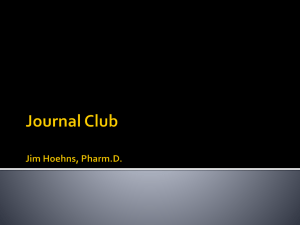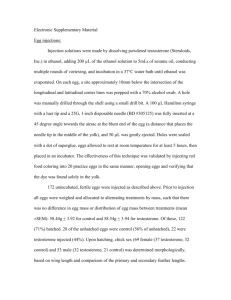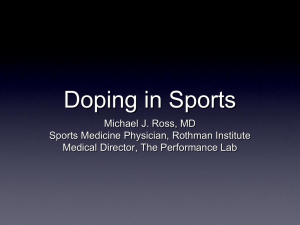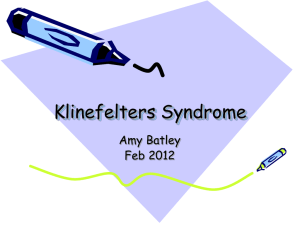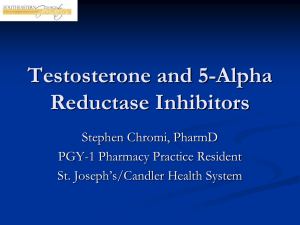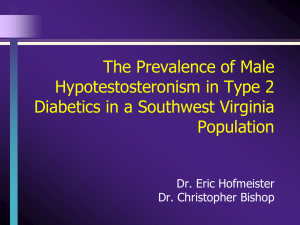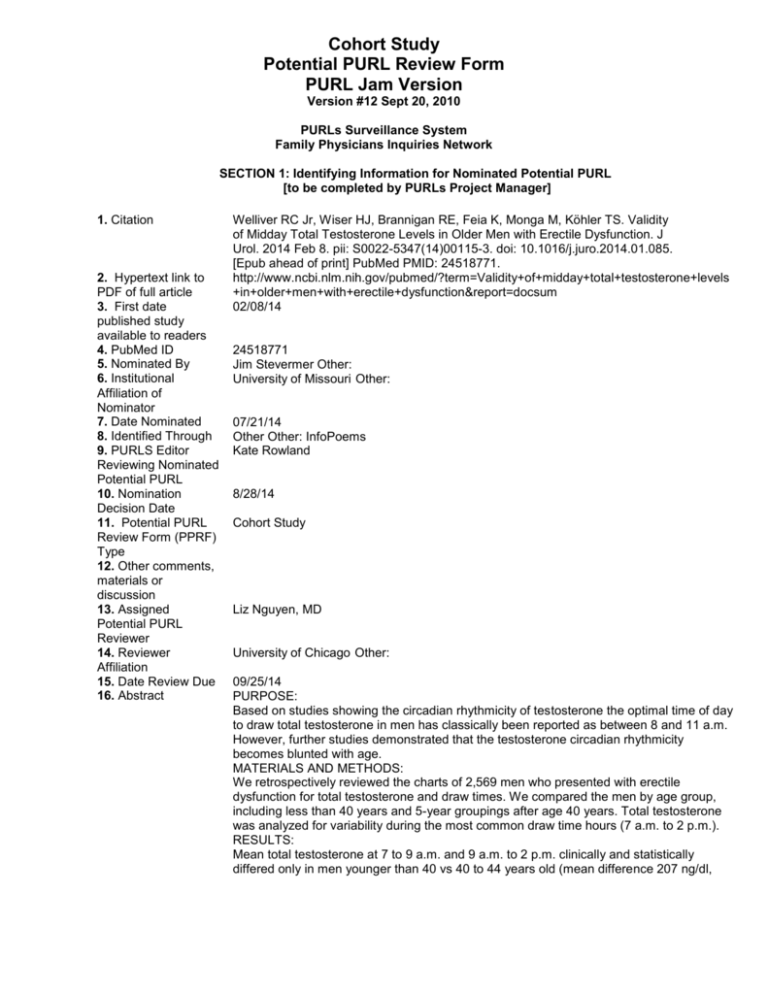
Cohort Study
Potential PURL Review Form
PURL Jam Version
Version #12 Sept 20, 2010
PURLs Surveillance System
Family Physicians Inquiries Network
SECTION 1: Identifying Information for Nominated Potential PURL
[to be completed by PURLs Project Manager]
1. Citation
2. Hypertext link to
PDF of full article
3. First date
published study
available to readers
4. PubMed ID
5. Nominated By
6. Institutional
Affiliation of
Nominator
7. Date Nominated
8. Identified Through
9. PURLS Editor
Reviewing Nominated
Potential PURL
10. Nomination
Decision Date
11. Potential PURL
Review Form (PPRF)
Type
12. Other comments,
materials or
discussion
13. Assigned
Potential PURL
Reviewer
14. Reviewer
Affiliation
15. Date Review Due
16. Abstract
Welliver RC Jr, Wiser HJ, Brannigan RE, Feia K, Monga M, Köhler TS. Validity
of Midday Total Testosterone Levels in Older Men with Erectile Dysfunction. J
Urol. 2014 Feb 8. pii: S0022-5347(14)00115-3. doi: 10.1016/j.juro.2014.01.085.
[Epub ahead of print] PubMed PMID: 24518771.
http://www.ncbi.nlm.nih.gov/pubmed/?term=Validity+of+midday+total+testosterone+levels
+in+older+men+with+erectile+dysfunction&report=docsum
02/08/14
24518771
Jim Stevermer Other:
University of Missouri Other:
07/21/14
Other Other: InfoPoems
Kate Rowland
8/28/14
Cohort Study
Liz Nguyen, MD
University of Chicago Other:
09/25/14
PURPOSE:
Based on studies showing the circadian rhythmicity of testosterone the optimal time of day
to draw total testosterone in men has classically been reported as between 8 and 11 a.m.
However, further studies demonstrated that the testosterone circadian rhythmicity
becomes blunted with age.
MATERIALS AND METHODS:
We retrospectively reviewed the charts of 2,569 men who presented with erectile
dysfunction for total testosterone and draw times. We compared the men by age group,
including less than 40 years and 5-year groupings after age 40 years. Total testosterone
was analyzed for variability during the most common draw time hours (7 a.m. to 2 p.m.).
RESULTS:
Mean total testosterone at 7 to 9 a.m. and 9 a.m. to 2 p.m. clinically and statistically
differed only in men younger than 40 vs 40 to 44 years old (mean difference 207 ng/dl,
95% CI 98-315, p = 0.0004 vs 149 ng/dl, 95% CI 36-262, p = 0.01). No other group
showed a clinically and statistically significant difference between those periods.
CONCLUSIONS:
Total testosterone in men with erectile dysfunction who are younger than 45 years should
be drawn as close to 7 a.m. as possible because a statistically and clinically relevant
decrease in testosterone will occur during the course of the day. Men older than 45 years
with erectile dysfunction can have total testosterone drawn at any time before 2 p.m.
without misleading results.
Copyright © 2014 American Urological Association Education and Research, Inc.
Published by Elsevier Inc. All rights reserved.
KEYWORDS:
age groups; circadian rhythm; erectile dysfunction; testis; testosterone
17. Pending PURL
Review Date
1 The study addresses an
appropriate and clearly
focused question.
2 The two groups being
studied are selected from
source populations that are
comparable in all respects
other than the factor under
investigation.
3 The study indicates how
many of the people asked to
take part did so, in each of the
groups being studied
4 The likelihood that some
eligible subjects might have
the outcome at the time of
enrolment is assessed and
taken into account in the
analysis.
5 What percentage of
individuals or clusters
recruited into each arm of the
study dropped out before the
study was completed?
6 Comparison is made
between full participants and
those lost to follow up, by
exposure status.
7 The outcomes are clearly
defined.
SECTION 2: Critical Appraisal of Validity
[to be completed by the Potential PURL Reviewer]
Well covered
Not addressed
Adequately addressed
Not reported
Poorly addressed
Not applicable
Comments: 1. Does testosterone level vary by time of day
2. Does the testosterone level diurnal variation differ by patient age
Well covered
Not addressed
Adequately addressed
Not reported
Poorly addressed
Not applicable
Comments: 2,569 males ages 26-84 presenting with CC: ED.No information
regarding past medical history, current medications that may represent
confounding variables.
Well covered
Adequately addressed
Poorly addressed
Comments: Retrospective study
Not addressed
Not reported
Not applicable
Well covered
Not addressed
Adequately addressed
Not reported
Poorly addressed
Not applicable
Comments: The outcome was testosterone level.
None, this was a restrospective study
Well covered
Not addressed
Adequately addressed
Not reported
Poorly addressed
Not applicable
Comments: No patients were lost to f/u as the study was retrospective
Well covered
Not addressed
Adequately addressed
Not reported
Poorly addressed
Not applicable
Comments: Variance in testosterone levels by time of day and patient age.
8 The assessment of outcome
is made blind to exposure
status
9 Where blinding was not
possible, there is some
recognition that knowledge of
exposure status could have
influenced the assessment of
outcome.
10 What are the key findings
of the study?
11 How was the study
funded? Any conflicts of
interest? Any reason to
believe that the results may
be influenced by other
interests?
Well covered
Not addressed
Adequately addressed
Not reported
Poorly addressed
Not applicable
Comments: Outcome was testosterone level. Blinding unnecessary as the outcome was a
lab level ( an objective-rather than subjective outcome)
Well covered
Not addressed
Adequately addressed
Not reported
Poorly addressed
Not applicable
Comments: Testosterone lab value is objective so blinding unnecessary.
Statistically significant Total Testosterone levels vary as the day progresses for men <
45 years old.
Funding not documented- possibly through the VA?
One author with ties to several Pharmaceutical companies that provide ED treatments.
SECTION 3: Review of Secondary Literature
[to be completed by the Potential PURL Reviewer]
Citation Instructions
For UpTo Date citations, use style modified from
http://www.uptodate.com/home/help/faq/using_UTD/index.html#cite & AMA style. Always
use Basow DS as editor & current year as publication year.
EXAMPLE: Auth I. Title of article. {insert author name if given, & search terms or title.} In:
Basow DS, ed. UpToDate [database online]. Waltham, Mass: UpToDate; 2009. Available
at: http://www.uptodate.com. {Insert dated modified if given.} Accessed February 12,
2009. {whatever date PPRF reviewer did their search.}
1. DynaMed excerpts
For DynaMed, use the following style:
Depression: treatment {insert search terms or title}. In: DynaMed [database online].
Available at: http://www.DynamicMedical.com. Last updated February 4, 2009. {Insert
dated modified if given.} Accessed June 5, 2009.{search date}
Testing overview:
•
in pubertal and postpubertal males
o
consider measuring morning total testosterone level in
patients with symptoms and signs of androgen deficiency (Endocrine Society Weak
recommendation, Very low-quality evidence)
o
if testosterone level is low
repeat testosterone level (Endocrine Society Strong
recommendation, Low-quality evidence)
measure luteinizing hormone (LH) and folliclestimulating hormone (FSH) levels (Endocrine Society Strong recommendation, Low-quality
evidence)
o
low total, free, or bioavailable testosterone on ≥ 2
occasions confirms diagnosis of hypogonadism
if high LH and FSH, likely diagnosis is primary
hypogonadism
if low or normal LH and FSH, likely diagnosis is secondary
hypogonadism
2. DynaMed
citation/access date
3. Bottom line
recommendation or
summary of evidence
from DynaMed
(1-2 sentences)
4. UpToDate excerpts
LH and FSH may be high, low, or normal in combined
primary and secondary hypogonadism
o
consider measuring free or bioavailable testosterone if
testosterone level is near lower limit of normal in patient with condition which might alter
sex hormone binding globulin concentration (Endocrine Society Weak recommendation,
Low-quality recommendation)
Title. Hypogonadism in Males Author. None listed In: DynaMed [database online].
Available at: www.DynamicMedical.com Last updated: May 2014. Accessed 9/21/14
Morning testosterone levels should be obtained in males presenting with signs of androgen
deficiency.
When during the day should the serum testosterone concentration be measured? —
Interpretation of serum testosterone measurements in young men should take into
consideration its diurnal fluctuation, which reaches a maximum at about 8 AM and a
minimum, approximately 70 percent of the maximum, at about 8 PM (figure 2) [7]. It is easier
to distinguish subnormal from normal when normal is higher, so the measurements should
always be made at 8 AM.
How often should testosterone be measured? — The serum testosterone concentration
fluctuates somewhat even early in the morning, although to a limited degree. If a single 8
AM value is well within the normal range, testosterone production can be assumed to be
normal. If a single 8 AM value is low or borderline low or does not fit with the clinical
findings, the measurement should be repeated once or twice before making the diagnosis
of hypogonadism.
5. UpToDate
citation/access date
6. Bottom line
recommendation or
summary of evidence
from UpToDate
(1-2 sentences)
7. PEPID PCP
excerpts
www.pepidonline.com
username: fpinauthor
pw: pepidpcp
8. PEPID
citation/access data
9. PEPID content
updating
Which form of testosterone should be measured? — Measurement of the serum total (free
plus protein-bound) testosterone concentration is usually an accurate reflection of
testosterone secretion. The normal range in most laboratories is about 300 to 800 ng/dL.
Measurement of the serum free testosterone concentration is worthwhile only when it is
suspected that an abnormality in testosterone binding to sex hormone-binding globulin
coexists with hypogonadism. The two most common situations of abnormal testosterone
binding are obesity, which reduces binding in proportion to the degree of obesity (figure 1)
[2], and male senescence, which increases binding slightly
Always use Basow DS as editor & current year as publication year.
Title.
Clinical features and diagnosis of male hypogonadism
Author. Peter J. Snyder MD In: UpToDate [database online]. Available at:
http://www.uptodate.com. Last updated: Jan 2013. Accessed9/21/14
Total testosterone can be measured for most patients. Timing of testosterone testing
should be at 8 AM. No distinction made for patient age.
Author.
Title.
In: PEPID [database online]. Available at:
. Accessed
http://www.pepidonline.com. Last updated:
1. Do you recommend that PEPID get updated on this topic?
Yes, there is important evidence or recommendations that are missing
No, this topic is current, accurate and up to date.
If yes, which PEPID Topic, Title(s):
2. Is there an EBM Inquiry (HelpDesk Answers and Clinical Inquiries) as indicated by the
EB icon ( ) that should be updated on the basis of the review?
Yes, there is important evidence or recommendations that are missing
No, this topic is current, accurate and up to date.
If yes, which Evidence Based Inquiry(HelpDesk Answer or Clinical Inquiry), Title(s):
10. Other excerpts
(USPSTF; other
guidelines; etc.)
AACE Hypogonadism Guidelines 2002: Total testosterone in the morning, if Total
Testosterone abnormal, draw free/bioavailable T levels. No distinction for age.
European Association of Urology: Obtain AM Testosterone levels.
11. Citations for other
excerpts
12. Bottom line
recommendation or
summary of evidence
from Other Sources
(1-2 sentences)
SECTION 4: Conclusions
[to be completed by the Potential PURL Reviewer; Revised by the Pending PURL Reviewer as needed]
1. Validity: How well does the study
minimize sources of internal bias
and maximize internal validity?
2. If 4.1 was coded as 4, 5, 6, or 7,
please describe the potential bias
and how it could affect the study
results. Specifically, what is the
likely direction in which potential
sources of internal bias might affect
the results?
3. Relevance: Are the results of this
study generalizable to and relevant
to the health care needs of patients
cared for by “full scope” family
physicians?
4. If 4.3 was coded as 4, 5, 6, or 7,
lease provide an explanation.
Give one number on a scale of 1 to 7
(1=extremely well; 4=neutral; 7=extremely poorly)
1
2
3
4
5
6
7
Unclear if confounding variables present- no information re: past medical
history, medication lists. Also testosterone levels weren't repeated in any
patients( ie- morning -vs-later afternoon testosterone levels in same patient)
5. Practice changing potential: If
the findings of the study are both
valid and relevant, does the practice
that would be based on these
findings represent a change from
current practice?
6. If 4.5 was coded as 1, 2, 3, or 4,
please describe the potential new
practice recommendation. Please
be specific about what should be
done, the target patient population
and the expected benefit.
7. Applicability to a Family
Medical Care Setting:
Is the change in practice
recommendation something that
Give one number on a scale of 1 to 7
(1=definitely a change from current practice; 4=uncertain; 7=definitely not a
change from current practice)
1
2
3
4
5
6
7
Give one number on a scale of 1 to 7
(1=extremely well; 4=neutral; 7=extremely poorly)
1
2
3
4
5
6
7
Unsure if most docs order AM testosterone levels still.
Give one number on a scale of 1 to 7
(1=definitely could be done in a medical care setting; 4=uncertain;
7=definitely could not be done in a medical care setting)
1
2
3
4
5
6
7
could be done in a medical care
setting by a family physician (office,
hospital, nursing home, etc), such
as a prescribing a medication,
vitamin or herbal remedy;
performing or ordering a diagnostic
test; performing or referring for a
procedure; advising, educating or
counseling a patient; or creating a
system for implementing an
intervention?
8. If you coded 4.7 as a 4, 5, 6 or 7,
please explain. .
9. Immediacy of Implementation:
Are there major barriers to
immediate implementation? Would
the cost or the potential for
reimbursement prohibit
implementation in most family
medicine practices? Are there
regulatory issues that prohibit
implementation? Is the service,
device, drug or other essentials
available on the market?
10. If you coded 4.9 as 4, 5, 6, or 7,
please explain why.
Give one number on a scale of 1 to 7
(1=definitely could be immediately applied; 4=uncertain; 7=definitely could
not be immediately applied)
1
2
3
4
5
6
7
11. Clinical meaningful outcomes
or patient oriented outcomes:
Are the outcomes measured in the
study clinically meaningful or patient
oriented?
12. If you coded 4.11 as a 4, 5, 6, or
7, please explain why.
Give one number on a scale of 1 to 7
(1=definitely clinically meaningful or patient oriented; 4=uncertain;
7=definitely not clinically meaningful or patient oriented)
1
2
3
4
5
6
7
13. In your opinion, is this a
Pending PURL?
Criteria for a Pending PURL:
Valid: Strong internal
scientific validity; the
findings appears to be true.
Relevant: Relevant to the
practice of family medicine
Practice changing: There is
a specific identifiable new
practice recommendation
that is applicable to what
family physicians do in
medical care settings and
seems different than current
practice.
Applicability in medical
setting:
Immediacy of
implementation
14. Comments on your response in
4.13
Is testosterone difference of 100-200 clinically meaningful since all values
were still within normal range? The difference may be detecting normal
versus low-normal values.
Give one number on a scale of 1 to 7
(1=definitely a Pending PURL; 4=uncertain; 7=definitely not a Pending
PURL)
1
2
3
4
5
6
7
Practice changer would be stop drawing morning Testosterone levels on
patients > 45. Whether it's a PURL depends on if docs are ordering AM levels.
SECTION 4.1: Diving for PURLs
[optional for the potential PURL reviewer -if you wish to be the author on the summary]
1. Study Summary- Please
summarize the study in 5-7
sentences
This is a retrospective cohort study evaluating whether diurnal variations in
testosterone level vary with patient age. Inclusion criteria included men presenting
to an outpatient VA clinic between 1986-2004 with a chief complaint of erectile
dysfunction who had at least one testosterone level drawn. Patients were excluded
if their testosterone level wasn't drawn between 7AM and 2PM and if their
testosterone level was outside the reference range of 50-1,000 ng/dL.
The testosterone levels of 2,569 patients meeting the study inclusion criteria were
analyzed by patient age(<40 and in 5 year intervals if > 40, ie. 40-44, 45-49, etc)
and time of blood draw ( 7-9 AM or 9AM-2PM). Each patient had only one
testosterone level drawn during the time period studied. Mean age of patients
studied was 63.
Statistically significant diurnal variations in testosterone level were only found in
patients <40 years old ( mean difference 207, p 0.0004), 40-44 years old( MD 149, p
0.0103) and 70-74 years old( MD 34, p 0.0379).
2. Criteria- note yes or no for
those which this study
meets
3. Bottom Line- one –two
sentences noting the bottom
line recommendation
4. Title Proposal
RELEVENT - Yes
VALID - Yes
CHANGE IN PRACTICE- ?
MEDICAL CARE SETTING - Yes
IMMEDIATELY APPLICABLE - Yes
CLINICALLY MEANINGFUL - ?
Evaluating symptoms of androgen deficiency should be performed using morning
testosterone levels only in men < 45 years old as diurnal variations in testosterone
levels are no longer significant in older men.
Drawing morning testosterone levels is no longer necessary.
SECTION 5: Editorial Decisions
[to be completed by the FPIN PURLs Editor or Deputy Editor]
1. FPIN PURLs editorial decision
(select one)
1 Pending PURL Review—Schedule for Review
2 Drop
3 Pending PURL
3. Follow up issues for Pending
PURL Reviewer
3. FPIN PURLS Editor making
decision
1 Bernard Ewigman
2 John Hickner
3 Sarah-Anne Schumann
4 Kate Rowland
4. Date of decision
5. Brief summary of decision
SECTION 6: Survey Questions for SERMO, PURLs Instant Polls and Other Surveys
[To be completed by the PURLs Survey Coordinator and PURLs Editor]
1. Current Practice Question for
Surveys
2. Barriers to Implementation
Question for Surveys
3. Likelihood of Change Question
for Surveys
4. Other Questions for Surveys
SECTION 7: Variables for Secondary Database Analyses
1. Population: Age, gender, race,
ethnicity
2. Diagnoses
3. Drugs or procedures
SECTION 8: Pending PURL Review Assignment
[to be completed by PURLs Project Manager
1. Person Assigned for
Pending PURL Review
2. Date Pending PURL Review is
due
SECTION 9: Pending PURL Review
[to be completed by the Pending PURL Reviewer]
1. Did you address the follow up
issues identified at the PURL Jam
(Section 5.2). Add comments as
needed.
Yes
No
Not applicable
Comments:
2. Did you review the Sermo poll &
Instant Poll results (if available)?
Add comments as needed.
Yes
No
Not applicable
Comments:
3. Did you modify Sections 2, 3, or
4? Add comments as needed.
Yes
No
Not applicable
Comments:
SECTION 10: PURL Authoring Template
[to be completed by the assigned PURL Author]
Author Citation Information (Name, Degrees,
Affiliation)
1. Practice Changer
2. Illustrative Case
3. Background/
Clinical Context/Introduction/Current Practice/
4. Study Summary
5. What’s New
6. Caveats
7. Challenges to Implementation
8. Acknowledgment Sentence
The PURLs Surveillance System is supported in part by
Grant Number UL1RR024999 from the National Center For
Research Resources, a Clinical Translational Science
Award to the University of Chicago. The content is solely the
responsibility of the authors and does not necessarily
represent the official views of the National Center For
Research Resources or the National Institutes of Health.
If using UHC data:
We acknowledge Sofia Medvedev of University
HealthSystem Consortium (UHC) in Oak Brook, IL for
analysis of the National Ambulatory Medical Care Survey
data.
9. References



